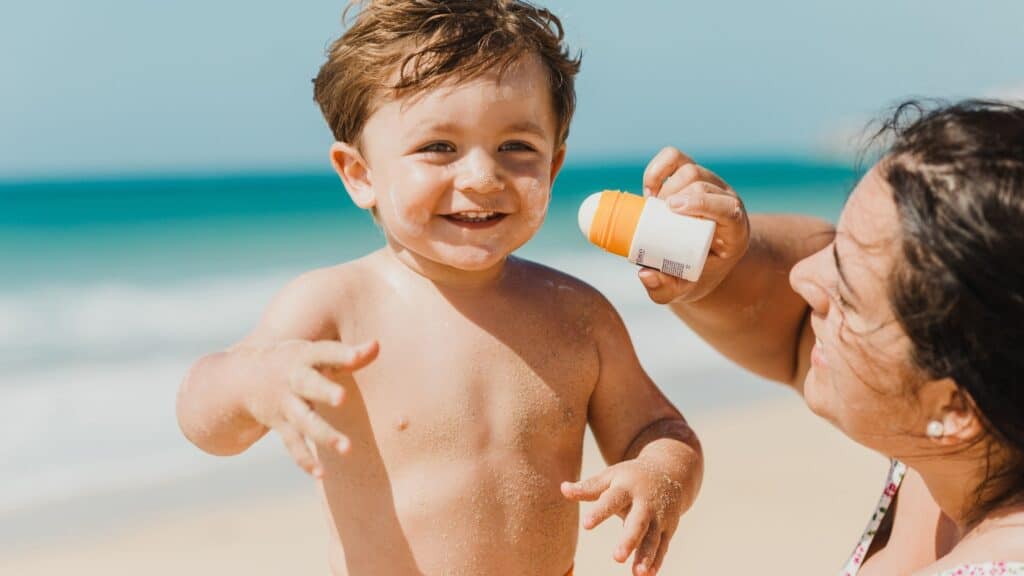As a pediatric nurse with over a decade of experience—many of those years spent in the ER—I’ve seen firsthand how damaging sun exposure can be for little ones. Babies and kids have thinner, more sensitive skin than adults, making them more vulnerable to sunburn, dehydration, and long-term skin damage, even after just a brief time outside.
And the risks aren’t just short-term. Research shows that even one blistering sunburn in childhood nearly doubles the risk of developing melanoma as an adult. That statistic stays with me, not just as a nurse, but as a mom of two living in Southwest Florida, where the sun shines nearly every day.
Whether we’re at the park, the pool, or just out for a walk on a cloudy day, protecting my kids’ skin is a daily priority. In this guide, I’m sharing evidence-based, nurse-approved sunscreen tips for babies and kids so you can feel confident keeping your little ones safe. From choosing the right baby sunscreen to applying it correctly (and not missing those easy-to-forget spots), here’s what every caregiver should know before heading outdoors.
How to Choose the Best Sunscreen for Babies and Kids
Walk through any drugstore sunscreen aisle, and it’s easy to feel overwhelmed. Mineral vs. chemical? SPF 30 or 50? Water-resistant? For babies, for kids, for sensitive skin? The truth is, not all sunscreens are the same, and what works for adults may not be the best choice for your child’s developing skin.
As a nurse and mom, I follow the American Academy of Pediatrics (AAP) sun safety recommendations. Here’s what I look for when choosing a sunscreen for babies and kids:
Choose a mineral (physical) sunscreen
Look for sunscreens that contain zinc oxide or titanium dioxide as the active ingredients. These ingredients, which the Food and Drug Administration (FDA) defines as “generally recognized as safe and effective” or GRASE, are known as mineral or physical blockers because they sit on top of the skin and reflect UV rays. They’re less likely to irritate sensitive skin and start working immediately—unlike chemical sunscreens, which absorb into the skin and need time to activate.
Look for broad-spectrum protection
Broad-spectrum sunscreens protect against both UVA and UVB rays. UVB rays cause sunburn, but UVA rays penetrate deeper and contribute to skin aging and increased skin cancer risk. You want protection from both.
Stick with SPF 30 to 50
Higher SPF doesn’t always mean better. The AAP and the American Academy of Dermatology (AAD) both recommend SPF 30 or higher, with SPF 50 offering slightly more protection. Anything over SPF 50 adds only marginal benefit and may give a false sense of security.
Make sure it’s water-resistant
If your child is playing in water or sweating in the sun (so, basically always), choose a water-resistant sunscreen labeled to last 40 or 80 minutes. Don’t forget to reapply!
Avoid added fragrance and unnecessary chemicals
formula when possible, especially for babies or kids with eczema or reactive skin.
Skip sunscreen entirely for babies under 6 months (when possible)
For infants under 6 months, the AAP recommends keeping them out of direct sunlight entirely. Use shade, hats, and protective clothing instead. If sun exposure is unavoidable, a small amount of baby-specific mineral sunscreen can be applied to exposed areas like the face or backs of hands—but always check with your pediatrician first.
How to Apply Sunscreen Effectively
Even the best sunscreen won’t work if it’s not applied properly—and in my experience, most parents are either using too little or not reapplying often enough. The good news: A few small adjustments can make a big difference in how well sunscreen protects your child’s skin.
Here’s what you need to know to get it right:
Use enough—and then some
Most people under-apply sunscreen. For kids, aim for about one ounce of lotion (roughly the size of a shot glass) to cover their entire body. If you’re only applying a dab here and there, it’s not enough to offer full protection.
Apply 15 to 30 minutes before sun exposure
This gives the sunscreen time to form a protective barrier on the skin—especially important for chemical sunscreens, which need time to absorb. Mineral sunscreens start working right away, but a little extra settling time still helps improve coverage.
Don’t forget the easy-to-miss spots
Make sure you’re covering areas that often get skipped, like the tops of the ears, the back of the neck, the tops of feet, and behind the knees. If your child has thin or fine hair, apply sunscreen along the part line or have them wear a wide-brimmed hat.
Reapply every two hours—or sooner
Sunscreen wears off, especially with water play or sweating. Reapply at least every two hours, and immediately after swimming or towel drying—even if the label says “water-resistant.”
What about spray sunscreens?
Spray sunscreens might seem more convenient, especially with wiggly toddlers, but they can be tricky. The AAD suggests sprays are less reliable when it comes to even coverage. And because they’re easy to under-apply or miss spots, they may not offer the same level of protection.
If you do use a spray, spray enough to visibly cover your child’s skin with the product, then use your hands to rub it in. Never spray directly onto your child’s face or into the wind. To avoid accidentally spraying sunscreen into your child’s eyes or mouth, spray the sunscreen into your hands then rub it onto their face, ears, and neck.
Common Sunscreen Mistakes to Avoid
Even the most well-meaning caregivers can make simple sunscreen slip-ups, especially when you’re rushing to get everyone out the door. Here are some of the most common mistakes I’ve seen (and made myself), along with how to avoid them:
- Using expired sunscreen: Sunscreen breaks down over time, making it less effective. Check the expiration date on the bottle, and if it’s past its prime—or has been sitting in a hot car for months—it’s time to toss it.
- Applying too little: A thin layer won’t cut it. Make sure you’re using enough to fully cover all exposed skin (about a shot glass–sized amount for a child), and don’t forget to reapply.
- Missing key spots: The ears, back of the neck, scalp (especially parts), tops of feet, and backs of hands are some of the most commonly missed areas—and some of the first to burn.
- Not applying early enough: Chemical sunscreen (both lotion and spray forms) should be applied 15 to 30 minutes before sun exposure. Slathering it on as your child runs toward the water won’t give it enough time to work.
- Skipping sunscreen on cloudy days: Up to 80% of UV rays can still reach the skin even when it’s overcast. If you’re outside for any length of time, sunscreen is still a must.
- Relying solely on sunscreen: Sunscreen is important, but it’s not your only line of defense. Protective clothing, hats, sunglasses, and seeking shade during peak hours all play a role in keeping your child safe.
Beyond Sunscreen: Sun Safety Tips for Kids
Sunscreen is important, but it works best when paired with other smart sun safety habits:
- Avoid peak hours by staying in the shade between 10 a.m. and 4 p.m., when the sun is strongest.
- Dress for protection with lightweight, long-sleeved UPF-rated clothing and hats.
- Keep kids hydrated by offering water frequently, even if they don’t ask for it.
- Use sunglasses that block 100% of UVA and UVB rays to protect their eyes.
- Watch for signs of overheating—and read our heat exhaustion in kids guide for what to look for.
Best Sunscreen for Kids (That’s Also Good for the Environment)
Looking for a sunscreen that’s safe for your child’s skin and gentle on the planet? These are my top go-to picks as a pediatric nurse and mom—each one is mineral-based, water-resistant, and free from harsh chemicals that can irritate skin or harm marine life.
1. Neutrogena Sheer Zinc Kids Mineral Sunscreen Stick SPF 50
This is my everyday MVP for quick, mess-free application, especially on little faces. It goes on smoothly, stays put, and doesn’t melt in the Florida heat.
2. Baby Bum Mineral Sunscreen Lotion SPF 50
Fragrance-free and super gentle, this one’s great for babies and toddlers with sensitive skin. It rubs in better than most mineral sunscreens and doesn’t leave them chalky or greasy.
3. ThinkKids Safe Sunscreen SPF 50+
I love that this one uses non-nano zinc and reef-safe ingredients. It’s a solid all-over body option for long beach days or outdoor adventures.
4. Blue Lizard Kids Mineral Sunscreen SPF 50+
This brand is a favorite among dermatologists for a reason—it’s broad-spectrum, water-resistant, and free of parabens, fragrances, and oxybenzone.
5. Babo Botanicals Sheer Zinc Mineral Sunscreen Lotion SPF 30
Made with organic plant-based ingredients and soothing botanicals like calendula and chamomile, this one’s perfect for kids with extra-sensitive or eczema-prone skin.
Sunscreen Tips for Babies and Kids: Why Sun Protection Is a Shared Responsibility
Whether you’re a parent, nanny, or another trusted caregiver, sun safety is one of the most important ways we protect the little ones in our care. Kids won’t remember to slather up on their own, grab a hat, or reapply after swimming— that’s where we come in.
Building simple habits that stick make a big difference in keeping your child’s skin safe and healthy: choose a sunscreen that works, apply it generously, cover the easy-to-miss spots, and remember to reapply (yes, even when they’re having so much fun they “don’t need it”).
With the right tools and a little teamwork, keeping kids safe in the sun becomes second nature—and one more way we show up for them, day after day.
FAQ About Sunscreen for Babies and Kids
Is there a difference between kids and regular sunscreen?
Yes—kids’ sunscreens are often formulated with fewer irritating ingredients and typically rely on mineral-based filters like zinc oxide or titanium dioxide. These are gentler on sensitive skin and less likely to cause reactions. Some adult sunscreens contain alcohol, fragrances, or chemical UV filters that may be too harsh for younger skin.
When can babies wear sunscreen?
The AAP recommends keeping babies under 6 months out of direct sunlight whenever possible. If shade and protective clothing aren’t an option, a small amount of mineral sunscreen can be applied to exposed areas like the face or back of the hands. Always talk to your pediatrician first.
Can kids use adult sunscreen?
Technically, yes—if it’s a mineral sunscreen without added fragrance or harsh ingredients, it’s generally safe. Because many adult sunscreens contain chemicals or added scents that can irritate young skin, it’s usually best to stick with a kids-specific or baby-safe formula designed for sensitive skin. But in a pinch, the American Academy of Pediatrics recommends using any sunscreen rather than none at all—as long as it’s an oxybenzone-free formula.
What’s the difference between mineral and chemical sunscreen for kids?
Mineral sunscreens (with zinc oxide or titanium dioxide) sit on top of the skin and reflect UV rays, while chemical sunscreens absorb into the skin and neutralize rays from within. For babies and young kids, mineral sunscreens are usually the better choice—they start working immediately and are less likely to cause irritation. Studies
Can sunscreen cause a rash or skin irritation in babies?
It can, especially if the formula contains fragrances, preservatives, or chemical filters. If your baby has eczema or very sensitive skin, look for hypoallergenic, fragrance-free mineral sunscreens. Always patch test on a small area first, and if a rash develops, stop use and check with your pediatrician.



